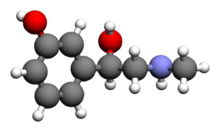Phenylephrine (ophthalmic)
Editor-In-Chief: C. Michael Gibson, M.S., M.D. [1]; Associate Editor(s)-in-Chief: Aparna Vuppala, M.B.B.S. [2]
Disclaimer
WikiDoc MAKES NO GUARANTEE OF VALIDITY. WikiDoc is not a professional health care provider, nor is it a suitable replacement for a licensed healthcare provider. WikiDoc is intended to be an educational tool, not a tool for any form of healthcare delivery. The educational content on WikiDoc drug pages is based upon the FDA package insert, National Library of Medicine content and practice guidelines / consensus statements. WikiDoc does not promote the administration of any medication or device that is not consistent with its labeling. Please read our full disclaimer here.
Overview
Phenylephrine (ophthalmic) is an alpha-1 adrenergic receptor agonist that is FDA approved for the procedure of to dilate the pupil. Common adverse reactions include pain in eye, transient, ophthalmic solution.
Adult Indications and Dosage
FDA-Labeled Indications and Dosage (Adult)
Phenylephrine Hydrochloride Ophthalmic Solution, 2.5% and 10% is indicated to dilate the pupil.
General Dosing Recommendations
- In patients 1 year of age or greater, apply one drop of either Phenylephrine Hydrochloride Ophthalmic Solution, USP 2.5% or 10% every 3 to 5 minutes to the conjunctival fornix as required up to a maximum of 3 drops. If necessary, this dose may be repeated.
- In order to obtain a greater degree of mydriasis, Phenylephrine Hydrochloride Ophthalmic Solution, USP 10% may be needed.
Off-Label Use and Dosage (Adult)
Guideline-Supported Use
There is limited information regarding Off-Label Guideline-Supported Use of Phenylephrine (ophthalmic) in adult patients.
Non–Guideline-Supported Use
There is limited information regarding Off-Label Non–Guideline-Supported Use of Phenylephrine (ophthalmic) in adult patients.
Pediatric Indications and Dosage
FDA-Labeled Indications and Dosage (Pediatric)
Phenylephrine Hydrochloride Ophthalmic Solution, 2.5% and 10% is indicated dilate the pupil
General Dosing Recommendations
- In patients 1 year of age or greater, apply one drop of either Phenylephrine Hydrochloride Ophthalmic Solution, USP 2.5% or 10% every 3 to 5 minutes to the conjunctival fornix as required up to a maximum of 3 drops. If necessary, this dose may be repeated.
- In order to obtain a greater degree of mydriasis, Phenylephrine Hydrochloride Ophthalmic Solution, USP 10% may be needed.
Pediatric Patients Less Than 1 Year of Age
- In pediatric patients less than 1 year of age, one drop of Phenylephrine Hydrochloride Ophthalmic Solution, USP 2.5% should be instilled at 3 to 5 minute intervals up to a maximum of 3 drops per eye.
Off-Label Use and Dosage (Pediatric)
Guideline-Supported Use
There is limited information regarding Off-Label Guideline-Supported Use of Phenylephrine (ophthalmic) in pediatric patients.
Non–Guideline-Supported Use
There is limited information regarding Off-Label Non–Guideline-Supported Use of Phenylephrine (ophthalmic) in pediatric patients.
Contraindications
Cardiac and Endocrine Disease
- Phenylephrine Hydrochloride Ophthalmic Solution, USP 10% is contraindicated in patients with hypertension or thyrotoxicosis. Phenylephrine Hydrochloride Ophthalmic Solution, USP 2.5% should be used in these patients.
Pediatric Patients Less Than 1 Year of Age
- Phenylephrine Hydrochloride Ophthalmic Solution, USP 10% is contraindicated in pediatric patients less than 1 year of age due to the increased risk of systemic toxicity. Phenylephrine Hydrochloride Ophthalmic Solution, USP 2.5% should be used in these patients
Warnings
Topical Ophthalmic Use Only
- Phenylephrine Hydrochloride Ophthalmic Solution, 2.5% and 10% is not indicated for injection.
Cardiovascular Reactions
- There have been reports of serious cardiovascular reactions, including ventricular arrhythmias and myocardial infarctions, in patients using phenylephrine 10%. These episodes, some fatal, have usually occurred in patients with pre-existing cardiovascular diseases. Phenylephrine Hydrochloride Ophthalmic Solution, USP 2.5% should be used in these patients.
Elevation in Blood Pressure
- A significant elevation in blood pressure is not common but has been reported following conjunctival instillation of recommended doses of phenylephrine 10%. The risk is less with phenylephrine 2.5%. Caution should be exercised with the use of phenylephrine 10% in pediatric patients less than 5 years of age and patients with hyperthyroidism, or cardiovascular disease. The post-treatment blood pressure of patients with cardiac and endocrine diseases and any patients who develop symptoms should be carefully monitored.
Rebound Miosis
- Rebound miosis has been reported one day after receiving phenylephrine hydrochloride ophthalmic solution, and re instillation of the drug produced a lesser mydriatic effect.
Adverse Reactions
Clinical Trials Experience
- The following serious adverse reactions are described below and elsewhere in the labeling: • Cardiac Disease • Elevation in Blood Pressure
- The following adverse reactions have been identified following use of phenylephrine hydrochloride ophthalmic solution. Because these reactions are reported voluntarily from a population of uncertain size, it is not always possible to reliably estimate their frequency or establish a causal relationship to drug exposure.
Ocular Adverse Reactions
- Eye pain and stinging on instillation, temporary blurred vision and photophobia, and conjunctival sensitization may occur.
Systemic Adverse Reactions
- A marked increase in blood pressure has been reported particularly, but not limited to low weight premature neonates, infants and hypertensive patients.
- Cardiovascular reactions which have occurred primarily in hypertensive patients following topical ocular use of phenylephrine hydrochloride ophthalmic solution 10% solution include marked increase in blood pressure, syncope, myocardial infarction, tachycardia, arrhythmia and subarachnoid hemorrhage.
Postmarketing Experience
There is limited information regarding Postmarketing Experience of Phenylephrine (ophthalmic) in the drug label.
Drug Interactions
- Agents That May Exaggerate Pressor Responses
- Concomitant use of phenylephrine and atropine may enhance the pressor effects and induce tachycardia in some patients. Phenylephrine may potentiate the cardiovascular depressant effects of some inhalation anesthetic agents.
Use in Specific Populations
Pregnancy
- Animal reproduction studies have not been conducted with topical phenylephrine. It is also not known whether phenylephrine can cause fetal harm when administered to a pregnant woman or can affect reproduction capacity. Phenylephrine hydrochloride should be given to a pregnant woman only if clearly needed.
Pregnancy Category (AUS):
There is no Australian Drug Evaluation Committee (ADEC) guidance on usage of Phenylephrine (ophthalmic) in women who are pregnant.
Labor and Delivery
There is no FDA guidance on use of Phenylephrine (ophthalmic) during labor and delivery.
Nursing Mothers
- It is not known whether this drug is excreted in breast milk. Because many drugs are excreted in human milk, caution should be exercised when Phenylephrine Hydrochloride Ophthalmic Solution, 2.5% and 10% is administered to a nursing woman.
Pediatric Use
- Phenylephrine Hydrochloride Ophthalmic Solution, 10% is contraindicated in pediatric patients less than 1 year of age infants. Phenylephrine Hydrochloride Ophthalmic Solution, 2.5% should be used in these patients
Geriatic Use
- No overall differences in safety and effectiveness have been observed between elderly and younger adult patients.
Gender
There is no FDA guidance on the use of Phenylephrine (ophthalmic) with respect to specific gender populations.
Race
There is no FDA guidance on the use of Phenylephrine (ophthalmic) with respect to specific racial populations.
Renal Impairment
There is no FDA guidance on the use of Phenylephrine (ophthalmic) in patients with renal impairment.
Hepatic Impairment
There is no FDA guidance on the use of Phenylephrine (ophthalmic) in patients with hepatic impairment.
Females of Reproductive Potential and Males
There is no FDA guidance on the use of Phenylephrine (ophthalmic) in women of reproductive potentials and males.
Immunocompromised Patients
There is no FDA guidance one the use of Phenylephrine (ophthalmic) in patients who are immunocompromised.
Administration and Monitoring
Administration
- Ophthalmic
Monitoring
There is limited information regarding Monitoring of Phenylephrine (ophthalmic) in the drug label.
IV Compatibility
There is limited information regarding IV Compatibility of Phenylephrine (ophthalmic) in the drug label.
Overdosage
- Overdosage of phenylephrine may cause a rapid rise in blood pressure. It may also cause headache, anxiety, nausea, and vomiting, and ventricular arrhythmias. Prompt injection of a rapidly acting alpha-adrenergic blocking agent such as phentolamine has been recommended.
Pharmacology
Mechanism of Action
- Phenylephrine is an alpha-1 adrenergic receptor agonist used for dilation of the pupil due to its vasoconstrictor and mydriatic action. Phenylephrine possesses predominantly α-adrenergic effects. In the eye, phenylephrine acts locally as a potent vasoconstrictor and mydriatic, by constricting ophthalmic blood vessels and the radial muscle of the iris.
Structure
- Phenylephrine Hydrochloride Ophthalmic Solution, USP 2.5% and 10% is a sterile, clear, colorless, topical mydriatic agent for ophthalmic use. The chemical name is (R)-3-hydroxy-α-[(methylamino)methyl]benzenemethanol hydrochloride. Phenylephrine hydrochloride is represented by the following structural formula:
- Phenylephrine hydrochloride has a molecular weight of 203.67 and an empirical formula of C9H13NO2-HCl.
- Each mL of Phenylephrine Hydrochloride Ophthalmic Solution, 2.5% contains: ACTIVE: phenylephrine hydrochloride 25 mg (2.5%); INACTIVES: sodium phosphate monobasic, sodium phosphate dibasic; boric acid, water for injection. Hydrochloric acid and/or sodium hydroxide may be added to adjust pH (6.0-6.4). The solution has a tonicity of 500 mOsm/kg. PRESERVATIVE: benzalkonium chloride 0.01%.
- Each mL of Phenylephrine Hydrochloride Ophthalmic Solution, 10% contains: ACTIVE: phenylephrine hydrochloride 100 mg (10.0%); INACTIVES: sodium phosphate monobasic, sodium phosphate dibasic; water for injection. Hydrochloric acid and/or sodium hydroxide may be added to adjust pH (6.3-6.7). The solution has a tonicity of 1000 mOsm/kg. PRESERVATIVE: benzalkonium chloride 0.01%.
Pharmacodynamics
- Maximal mydriasis occurs in 20 to 90 minutes with recovery after 3 to 8 hours.
- Systemic absorption of sufficient quantities of phenylephrine may lead to systemic α-adrenergic effects, such as rise in blood pressure which may be accompanied by a reflex atropine-sensitive bradycardia.
Pharmacokinetics
- The systemic exposure following topical administration of phenylephrine hydrochloride ophthalmic solution has not been studied. A higher systemic absorption is expected for the 10% solution than the 2.5% solution and when the corneal barrier function is compromised.
Nonclinical Toxicology
There is limited information regarding Nonclinical Toxicology of Phenylephrine (ophthalmic) in the drug label.
Clinical Studies
- Pupillary dilation following topical administration of phenylephrine hydrochloride ophthalmic solution has been demonstrated in controlled clinical studies in adults and pediatric patients with different levels of iris pigmentation. Pupil movement is generally seen within 15 minutes, maximal mydriasis between 20 to 90 minutes and recovery after 3 to 8 hours. Darker irides tend to dilate slower than lighter irides
How Supplied
- Phenylephrine Hydrochloride Ophthalmic Solution, USP 2.5% is supplied as a sterile, aqueous, topical ophthalmic solution with a fill volume of 15 mL in a 15 mL opaque, white low density polyethylene (LDPE) bottle with a linear low density polyethylene (LLDPE) dropper tip and red cap. (NDC 42702-102-15)
- Phenylephrine Hydrochloride Ophthalmic Solution, USP 10% is supplied as a sterile, aqueous, topical ophthalmic solution with a fill volume of 5 mL in a 10 mL opaque, white LDPE bottle with a LLDPE dropper tip and red cap. (NDC 42702-103-05)
Storage:
- Store in a refrigerator at 2° to 8°C (36°-46°F).
Storage
There is limited information regarding Phenylephrine (ophthalmic) Storage in the drug label.
Images
Drug Images
{{#ask: Page Name::Phenylephrine (ophthalmic) |?Pill Name |?Drug Name |?Pill Ingred |?Pill Imprint |?Pill Dosage |?Pill Color |?Pill Shape |?Pill Size (mm) |?Pill Scoring |?NDC |?Drug Author |format=template |template=DrugPageImages |mainlabel=- |sort=Pill Name }}
Package and Label Display Panel
{{#ask: Label Page::Phenylephrine (ophthalmic) |?Label Name |format=template |template=DrugLabelImages |mainlabel=- |sort=Label Page }}
Patient Counseling Information
- Advise patients not to touch the dropper tip to any surface as this may contaminate the solution.
- Inform patients they may experience sensitivity to light and should protect their eyes in bright illumination while their pupils are dilated.
Precautions with Alcohol
- Alcohol-Phenylephrine (ophthalmic) interaction has not been established. Talk to your doctor about the effects of taking alcohol with this medication.
Brand Names
There is limited information regarding Phenylephrine (ophthalmic) Brand Names in the drug label.
Look-Alike Drug Names
There is limited information regarding Phenylephrine (ophthalmic) Look-Alike Drug Names in the drug label.
Drug Shortage Status
Price
References
The contents of this FDA label are provided by the National Library of Medicine.
{{#subobject:
|Label Page=Phenylephrine (ophthalmic) |Label Name=Phenylephrine (ophthalmic)02.png
}}
{{#subobject:
|Label Page=Phenylephrine (ophthalmic) |Label Name=Phenylephrine (ophthalmic)03.png
}}
{{#subobject:
|Label Page=Phenylephrine (ophthalmic) |Label Name=Phenylephrine (ophthalmic)04.png
}}
{{#subobject:
|Label Page=Phenylephrine (ophthalmic) |Label Name=Phenylephrine (ophthalmic)05.png
}}
{{#subobject:
|Label Page=Phenylephrine (ophthalmic) |Label Name=Phenylephrine (ophthalmic)06.png
}}


